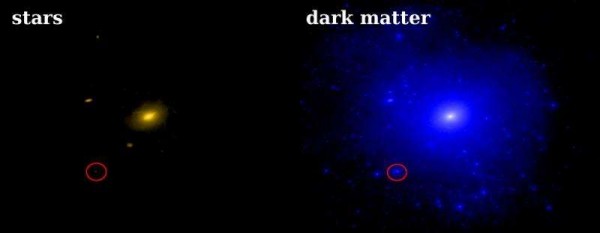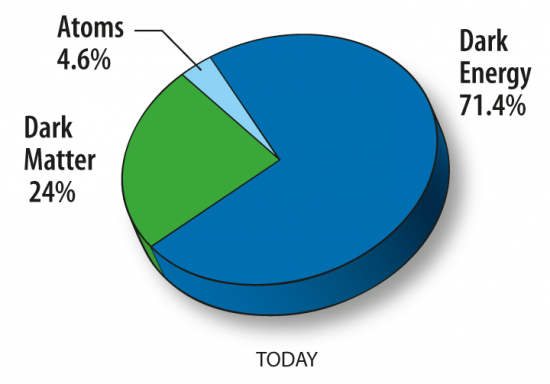
Last week (November 18, 2015), Caltech announced a new and surprising measurement for the mass of the small, nearby galaxy Triangulum II. Astronomers measured the velocities of six stars moving at extremely high speeds around this galaxy’s center. This measurement let them infer the force of gravity exerted on the stars by the galaxy as a whole … and, in this way, the astronomers determined the galaxy’s mass. It turns out the galaxy has much, much more mass than can be accounted for by its visible stars. These astronomers say they now believe they’re seeing a galaxy that contains a huge amount densely packed dark matter. They say the ratio of dark matter to visible matter in Triangulum II is the highest of any galaxy known.
In other words, Triangulum II might be a long-sought dark matter galaxy – mostly dark matter with few visible stars. If so, it’s a holy grail of sorts to astronomers, who have speculated about galaxies that are mostly dark matter and who have been trying to find one. Because this one is so nearby, it might be an answer to the hopes of astronomers who want to detect dark matter directly.
No one has yet seen or detected dark matter directly. We’ve only inferred its existence by the pull of its gravity, as was done in this study of Triangulum II.
The Caltech astronomers now say that Triangulum II could become a leading candidate for efforts to detect the signatures of dark matter. Located near one edge of our home galaxy, the Milky Way, Triangulum II has only about 1,000 stars that we can see. That’s in contrast to 300 billion stars for our Milky Way. Astronomer Evan Kirby led the CalTech research, with Judith Cohen. It was published its paper in the November 17, 2015 issue of the Astrophysical Journal Letters.
Kirby said in a statement:
After I had made my measurements, I was just thinking … wow.

Kirby also said that – because it contains so few visible stars – Triangulum II is a challenge to observe.
He said only six of its stars were luminous enough to see with the large Keck telescopes on Mauna Kea in Hawaii. These telescopes are currently among the largest telescopes in use.
It makes sense to think that some galaxies might have an abundance of dark matter, much more matter than visible stars, because there appears to be much, much more dark matter in our universe than ordinary matter. The percentages vary because the measurements are not exact, but the NASA graphic at the bottom of this post gives you some idea of the relationship between dark matter, dark energy and ordinary matter – that is, the stuff that makes up the visible galaxies, stars, planets and human beings.
Just over 4% of our universe is thought to exist as ordinary matter, the kind that makes up everything around us here on Earth.
The CalTech statement explained how Triangulum II could help astronomers detect dark matter directly:
Triangulum II could … become a leading candidate for efforts to directly detect the signatures of dark matter. Certain particles of dark matter, called supersymmetric WIMPs (weakly interacting massive particles), will annihilate one another upon colliding and produce gamma rays that can then be detected from Earth.
While current theories predict that dark matter is producing gamma rays almost everywhere in the universe, detecting these particular signals among other galactic noises, like gamma rays emitted from pulsars, is a challenge.
Triangulum II, on the other hand, is a very quiet galaxy. It lacks the gas and other material necessary to form stars, so it isn’t forming new stars—astronomers call it “dead.” Any gamma ray signals coming from colliding dark matter particles would theoretically be clearly visible.
However, not all astronomers agree that Kirby has measured the total mass of Triangulum II by measuring the velocities of the six stars near its center. The Caltech statement admitted:
Another group, led by researchers from the University of Strasbourg in France, measured the velocities of stars just outside Triangulum II and found that they are actually moving faster than the stars closer into the galaxy’s center—the opposite of what’s expected. This could suggest that the little galaxy is being pulled apart, or “tidally disrupted,” by the Milky Way’s gravity.
Kirby is forging ahead, though. He said his next steps are to confirm the other group’s findings and added:
If it turns out that those outer stars aren’t actually moving faster than the inner ones, then the galaxy could be in what’s called dynamic equilibrium. That would make it the most excellent candidate for detecting dark matter with gamma rays.

Bottom line: Astronomer Evan Kirby at Caltech measured the velocities of six stars in the nearby dwarf galaxy Triangulum II. This measurement let them infer the mass of the galaxy, which has only 1,000 visible stars. The surprising result was that Triangulum II may have the highest concentration of dark matter of any known galaxy. It may be a long-sought dark matter galaxy – mostly dark matter with few visible stars. Holy grail? Or is there another explanation?











